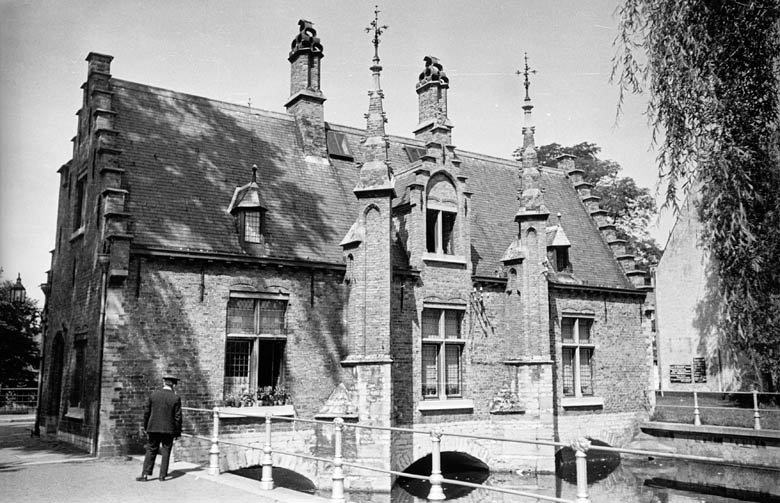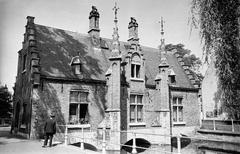
Sashuis Lock Keeper’s House Bruges: Visiting Hours, Tickets, and Travel Guide
Date: 14/06/2025
Introduction
Nestled along the tranquil canals of Bruges, the Sashuis (Lock Keeper’s House) is a captivating blend of medieval engineering and contemporary artisan culture. Originally constructed as a crucial part of Bruges’ water management network during the city’s commercial zenith, this 16th-century landmark now serves as a vibrant hub for local craftsmanship and cultural engagement. Whether you’re a history enthusiast, architecture lover, or simply seeking an authentic Bruges experience, this guide provides comprehensive information on the Sashuis’s history, significance, visiting hours, accessibility, ticketing, and insider travel tips.
For up-to-date details, visit the Handmade in Brugge website or the Visit Bruges tourism portal.
Table of Contents
- Historical Overview
- The Sashuis Today: An Artisan Hub
- Visiting Information
- What to See and Do
- Nearby Attractions
- Visitor Tips and Etiquette
- Frequently Asked Questions (FAQ)
- Summary and Final Tips
- References
Historical Overview
Early Origins and Medieval Foundations
Bruges’ origins date back to Roman times, but its transformation into a fortified settlement began in the 9th century under Baldwin I, Count of Flanders, as a defense against Viking invasions (The Traveling Cook Abroad). Over subsequent centuries, Bruges developed an intricate canal system that became central to its identity and growth. The Sashuis was later established as part of this system, responsible for controlling water flow and safeguarding the city’s bustling port area.
The Golden Age and Water Management
In the 12th and 13th centuries, Bruges flourished as a leading European trading center (World Guides). The Sashuis (meaning “Sluice House”) played an essential role in regulating canal water levels, preventing flooding, and supporting commerce by allowing the safe passage of goods and boats. Its strategic location at the Minnewater (Lake of Love) marked it as a linchpin in Bruges’ sophisticated water infrastructure.
Decline and Restoration
From the late 15th century, Bruges’ fortunes waned as the Zwin tidal inlet silted up, limiting access to the sea (USEFEW.COM). Fortunately, the city’s medieval architecture—including the Sashuis—remained largely preserved. Restoration projects in the 20th century, coupled with Bruges’ 2000 UNESCO World Heritage designation, have ensured the Sashuis’s continued presence as a symbol of civic ingenuity (The Traveling Cook Abroad).
The Sashuis Today: An Artisan Hub
Since its revitalization in 2022, the Sashuis has become the headquarters for “Handmade in Brugge,” a city-supported initiative promoting local crafts and artisans (Handmade in Brugge). The building has been adapted to house rotating exhibitions, hands-on workshops, and a boutique selling locally crafted goods. The Sashuis now stands at the crossroads of history and contemporary creativity, offering immersive experiences for visitors interested in Bruges’ living traditions.
Visiting Information
Opening Hours
- Wednesday to Saturday: 11:00 – 18:00
- Sunday, Monday, Tuesday: Closed
Hours may vary during special events and holidays; always confirm before visiting (Handmade in Brugge – Sashuis).
Admission and Tickets
- General Entry: Free admission to exhibitions and the artisan shop.
- Workshops and Special Events: Some events require advance booking and may have a fee.
Check the Handmade in Brugge website for current schedules and to reserve your spot for workshops.
Accessibility
- Wheelchair Access: The Sashuis is fully wheelchair accessible, with ramps and adapted facilities.
- Mobility Considerations: Nearby cobblestoned paths may be uneven; assistance is recommended for those with limited mobility.
Location and Getting There
- Address: Wijngaardplein 14, 8000 Brugge, Belgium
- By Train: 15-minute walk from Bruges’ main railway station (Station Brugge). Trains from Brussels and other Belgian cities are frequent (Visit Bruges).
- By Car: Park at Centrum-Station car park, then walk to Wijngaardplein.
- On Foot/Bike: Easily walkable from city center landmarks; bike rentals are nearby.
What to See and Do
- Historic Architecture: Admire the Sashuis’s 16th-century brickwork, stepped gables, and original sluice mechanisms, which evoke Bruges’ medieval past (Navaway).
- Artisan Exhibitions: Explore rotating displays of local craftsmanship, from lace-making to brewing.
- Workshops: Participate in hands-on craft sessions, often suitable for families and children.
- Boutique: Shop for unique, handmade Bruges souvenirs including textiles, ceramics, and jewelry.
- Artisan Route: Collect the “Handmade in Brugge” city guide or download the app for a self-guided tour of Bruges’ workshops and studios (Handmade in Brugge Guide).
- Photography: Capture the Sashuis and Minnewater at sunrise or sunset for the best light and reflections.
Nearby Attractions
- Minnewater (Lake of Love): Iconic, romantic lake adjacent to Sashuis (Visit Bruges).
- Begijnhof (Beguinage): UNESCO World Heritage site a short stroll away (Visit Bruges).
- Wijngaardplein: Lively square with cafés and canal boat tour departures.
- Belfry of Bruges, Market Square, Groeningemuseum: All within easy walking distance.
Visitor Tips and Etiquette
- Best Time to Visit: Early mornings or late afternoons offer quieter experiences and ideal photo conditions (Full Suitcase).
- Dress/Footwear: Wear comfortable shoes for cobbled streets; bring a rain jacket.
- Language: Dutch (Flemish) is official, but English and French are widely spoken (Quick Whit Travel).
- Souvenirs: Support local artisans by purchasing handmade goods at the Sashuis shop.
- Respect the Setting: Avoid touching historic mechanisms and keep noise levels low, especially near Begijnhof and Minnewater (Bruges Tourisme).
- Facilities: No public restrooms inside; use nearby cafés or public toilets.
Frequently Asked Questions (FAQ)
Is there an admission fee?
No, entry to the Sashuis is free. Some workshops or events may charge a fee.
Are guided tours available?
No regular guided tours, but staff and information panels can answer questions. Workshops offer guided experiences.
Is the Sashuis accessible for wheelchair users?
Yes, though surrounding cobblestones may pose challenges.
Can I buy souvenirs?
Yes, the on-site shop offers locally made artisan goods.
What are the opening hours?
Wednesday – Saturday: 11:00 – 18:00; closed Sunday–Tuesday. Check the official website for updates.
How can I participate in workshops?
Book in advance via the Handmade in Brugge website.
Summary and Final Tips
The Sashuis in Bruges is a testament to the city’s enduring spirit and adaptability, evolving from a vital piece of medieval water management to a modern-day center for artisanal excellence. Located steps from Minnewater and the Begijnhof, this free-to-visit site invites you to discover Bruges’ past and present through its architecture, exhibitions, workshops, and boutique.
Maximize your visit by exploring the artisan walking route, attending a workshop, and supporting Bruges’ creative community. For the latest information on hours, ticketing, and events, consult the Handmade in Brugge website or the official Visit Bruges portal.
Download the Handmade in Brugge app or the Audiala app for curated guides, and share your experience to inspire others to discover this remarkable corner of Bruges.
References
- The Traveling Cook Abroad
- World Guides
- USEFEW.COM
- VRT NWS
- Handmade in Brugge
- Lonely Planet
- Visit Bruges
- Navaway
- Quick Whit Travel
- Full Suitcase
- Allevents.in
- Bruges Tourisme











































































